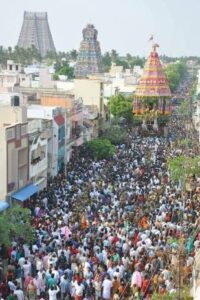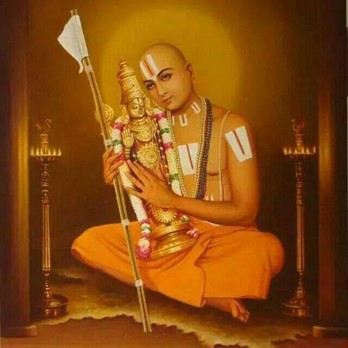 Srirangam is a city near Tiruchirapalli (Trichy) known for its famous Sri Ranganathaswamy Temple. This vast temple is believed to be the largest functional Hindu temple in the world, spread over an area of 156 acres. The massive temple complex is made up of 48 different temples. The chief deity of the temple is Lord Vishnu.
Srirangam is a city near Tiruchirapalli (Trichy) known for its famous Sri Ranganathaswamy Temple. This vast temple is believed to be the largest functional Hindu temple in the world, spread over an area of 156 acres. The massive temple complex is made up of 48 different temples. The chief deity of the temple is Lord Vishnu.
Visiting the Srirangam temple anytime is an experience in itself, visiting during the Chithirai Car Festival has a magic of its own. The Chithirai Car Festival is also known as Srirangam Viruppan Thirunal Chithirain Car Festival and is an important annual event of the temple. The festival is spread over 11 days and occurs in the Chithiral month of the Tamil Calendar. The 11-day festival starts with the temple flag hoisting or Dhwajarrohanam on the first day. The highlight of the festival is the procession of the deity through the streets of Srirangam mounted on a chariot decorated as different Vahanams (Vehicles). These Vahanas include Sesha Vahanam, Hanumantha Vahanam, Simha Vahanam, Yali Vahanam, and silver and gold horse Vahanam, among others.
The 640th Viruppan Thirunal Car Festival of Srirangam Temple was held today (19th April 2023) with thousands of devotees pulling the Temple Car with devotional fervor. This Temple Car Festival has historical significance as this festival used to be held for many centuries, but temporarily suspended for 60 years (between 1323-1383)..
In the year 1323, when Muslim invasion took place 12,000 devotees laid down their lives, in order to protect the deities of Srirangam Temple. The deities were taken out and was safely guarded at Madurai, Tirupathi and other places. The deities were reinstalled after a gap of 48 years due to the efforts of Vijayanagara Kings. Hence, the Car Festival couldn’t take place during this period. Even after reinstalling the deity in the Temple, the festival could not be held for 12 more years.
Viruppana Udayar, who was the son of 2nd Harihara and grandson of 1st Bukka of Vijayanagara empire, revived the Car Festival in the year 1383 hence the Car Festival has his name. Even to this daym on the first day of the festival, the contribution of Virupanna Udayar is mentioned. Seeing the pitiable financial condition of the Srirangam Temple due to the destruction of the temple by Muslim invaders and absence of daily poojas and rituals, which was introduced by Sri Ramanuja, Viruppana Udayar decided to revive the temple as well. He came forward and set an example by donating 17000 gold coins & 52 villages to the Srirangam Temple.
He also revived the Temple Car Festival and appealed to the general public to donate money, material etc., liberally to the festival for the revival of the temple. The news of the revival of the Temple Car Festival was sent to the nook and corner of the surrounding villages. Many felt whether people from the villages, which were ruined by Muslim invasion and who were reeling under poverty will come for the Car Festival and donate money/material. But to everyone’s surprise, people came in large numbers to witness festival. The villagers were thrilled to have the darshan of Sri Ranaganathaswamy after a lapse of 60 years. They also donated in cash and kind to the temple liberally.
As a result of this, the financial position of the temple improved and thereafter regained its past glory. Hence, the Car Festival in 1383 became a turning point both for the temple and the people of the villages surrounding the temple. It is the because of this the Car Festival of the temple gained significance and is being celebrated every year from 1383 onwards with gaiety. Another significant aspect is people have been donating money, food grains, livestock etc., to the Srirangam Temple every year for the last 640 years.
Some of the villagers offer their worship in unique ways:
1) Some of them get coconuts broken on their heads
2) Some do Angapradakshanam of four streets surrounding the temple.
In this connection, it is pertinent to point out that this Viruppana Udayar was also the one who built the Chakkarathazhvar Sannidhi in the Srirangam Temple, as per the temple records.

